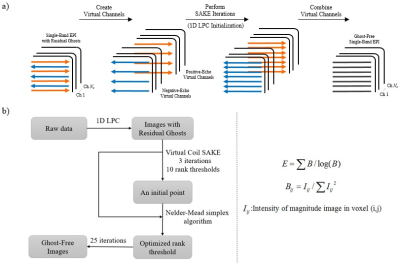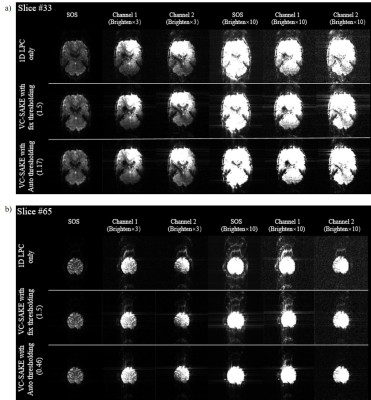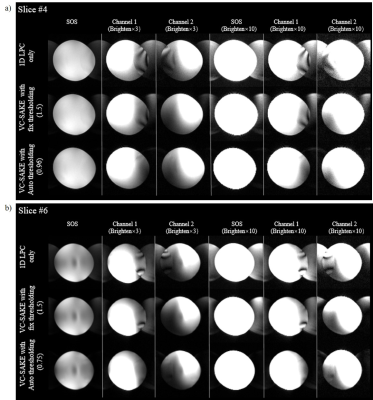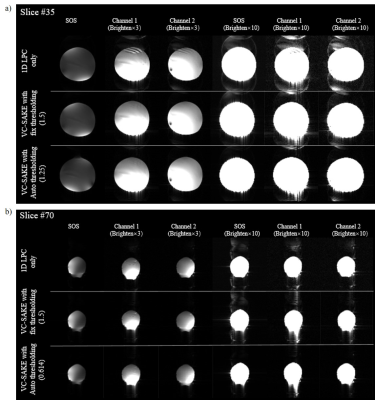4125
Robust Virtual Coil SAKE with Automatic Rank Thresholding for Removal of EPI Ghost Artifacts1Laboratory of Biomedical Imaging and Signal Processing, The University of Hong Kong, Hong Kong, China, 2Department of Electrical and Electronic Engineering, The University of Hong Kong, Hong Kong, China, 3Centre for Advanced Imaging, The University of Queensland, Brisbane, Australia
Synopsis
Ghost artifacts in EPI can arise from phase error between positive- and negative-echo and inter-shot phase error. Virtual coil SAKE (VC-SAKE) can be used to eliminate these phase errors simultaneously, but its performance relies on selection of parameters. In particular, proper rank thresholding is extremely important. In this study, we proposed to automatically determine the optimal rank threshold by minimizing the image entropy, and evaluated its performance with various datasets from different scanner systems.
Introduction
Ghost artifacts due to phase error between different readout directions and among different shots degrades EPI image quality. They cannot be fully corrected with linear phase correction (LPC) [1], since the phase errors often have 2D and nonlinear components. Virtual coil SAKE (VC-SAKE) was proposed to remove the residual ghost that cannot be fully corrected with LPC [2,3]. Performance of VC-SAKE largely depends on the selection of parameters, more specifically, properly rank thresholding plays a vital role in generating decent results. However, empirically selecting a proper rank threshold is challenging, since the rank is determined by many issues such as object support and coil configuration, etc. Noting that appearance of residual ghost results in increasing of image entropy, and it has already been used to determine the linear phase parameters for LPC. In this study, we utilize image entropy to achieve automatic rank thresholding.Methods
Proposed method: Figure. 1a revisits the basic workflow of VC-SAKE, which consists of three steps: virtual channel creation, SAKE iteration, and virtual channel combination. Figure. 1b illustrates the proposed method for automatic rank thresholding using VC-SAKE based on entropy minimization.
First, Nyquist ghosts are partially removed by 1D linear phase correction (LPC) based on entropy minimization [1].
Then, VC-SAKE is applied to eliminate the residual Nyquist ghosts using a small number of iterations (<3) and 10 rank thresholds. The rank threshold that achieves minimum image entropy is selected as initial point (the rank threshold corresponding to the smallest entropy).
After that, Nelder-Mead simplex algorithm [4] is used to find the optimal rank threshold with the step size set to 5%. In our implementation, 3 SAKE iterations were performed with kernel size=6×6, window-normalized rank threshold ranging from 0 to 5 (equivalent to rank = 0~180 without window-normalization). Finally, to evaluate the feasibility of this method, VC-SAKE with 25 iterations was performed using the automatically determined rank threshold to generate the final reconstruction.
Experiments
Phantom and human brain imaging at large-bore 7T system
Phantom and human brain data were collected on a 7T Siemens whole-body research scanner equipped with a 32-channel head coil. At MB=2, TE/TR=30/21670ms, flip angle=70°, matrix size=128×128, slice number=80, slice thickness=2mm.
Oblique view at small-bore 7T system
Experiments were performed at 7T (Bruker) equipped with a 4-channel surface head coil. The acquisition parameters are TE/TR=25/2000ms, flip angle=90˚, FOV=50×50mm2, matrix size=128×128, echo-spacing=0.32ms, slice number=6, slice thickness=2mm.
Rat brain imaging at small-bore 7T system
Experiments were performed at 7T (Bruker) using a 4-channel surface coil. The in vivo rat brain was imaged with parameters TE/TR=16/2000 ms, flip angle=90˚, slice thickness=1mm, FOV=40×40 mm2, and matrix size=96×96.
Results
Figure 2-5 show the imaging result in different scenarios. With 1D LPC correction, the reconstructed image still have severe ghosts. If VC-SAKE is performed with fixed thresholding, its performance varies across different slices or with different scanning systems. With improper thresholding, the final images still have distinct artifacts. With automatic thresholding, VC-SAKE have decent performance in all these scenarios, generating images with least ghost level.
Discussion and Conclusion
The proposed method have been evaluated with varieties of datasets from our on-going projects, results showed its robustness in finding the optimal rank in different scenarios. The proposed method can efficiently find the optimal rank threshold for image slices from different scanner systems, or with different spatial support. This method can be generally adapted to other low rank based ghost correction methods such as LORAKS [5] and ALOHA [6]. Future studies can further investigate the possibility of automatic determination of kernel sizes and iteration numbers.Acknowledgements
This work was supported by the Hong Kong Research Grant Council (Grants C7048-16G and HKU17103015 to E.X.W.).References
[1] Skare, S., Clayton, D. B., et al., ISMRM, 2006.
[2] Lyu, M., Barth, M., et al., ISMRM, 2017.
[3] Peter, J. Shin., Peder, E. Z. Larson., et al., Magn Reson Med, 2014. 72: p. 959-70.
[4] Lagarias, J. C. et al., SIAM Journal of Optimization, 1998. 9(1): p. 112–47.
[5] Lobos, RA., Kim, TH. et al., ISMRM, 2017.
[6] Lee, J., Jin, K. H., et al., Magn Reson Med, 2016. 76(6): p. 1775-89.
Figures




